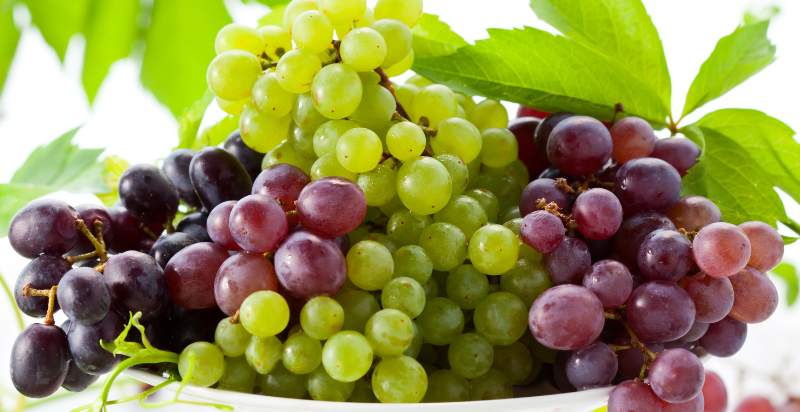Grapes are an ancient fruit that has been a part of the human diet since prehistoric times. The sweet, juicy, and nutritious nature of grapes has made them an important ingredient in many dishes and beverages throughout history. In addition to their culinary value, grapes are also widely used for making wine, grape juice, and raisins. Here is everything you need to know about grapes and their benefits.
What are Grapes?
Grapes are berries in wide varieties, shapes, sizes, and colors. They range from green to red, yellow to purple, and black. Grapes are usually sweet when ripe but can also be tart or sour, depending on the variety. They make for a refreshing snack on their own and are used in jams, jellies, wines, and juices.
Grapes have long been cultivated worldwide for their flavor and health benefits. Research suggests that grapes help reduce inflammation, protect against oxidative damage and even help with weight loss. They’re packed with beneficial vitamins like vitamins C and K and minerals such as magnesium, calcium, and iron. Grapes also contain a variety of polyphenols that can help protect against certain types of cancer.
Grapevines are often grown commercially, which means they’re not in the wild and don’t grow everywhere. However, you can still find some wild varieties in warm climates such as Europe, North America, and Asia. Grapes make a great addition to salads or desserts like pies or tarts. You can also enjoy them frozen for an icy treat on hot days!
No matter how you decide to eat, their grapes can be enjoyed year-round and provide a delicious and nutritious snack anytime.
History and Origin of Grapes:
Grapes have been cultivated for thousands of years, with evidence suggesting that they were first grown in the Middle East and Central Asia. The earliest known cultivation of grapes took place between 6000 to 5000 BC. Over time, grapes spread worldwide and were used to make wine, juice, raisins, and other products. In modern times, grapes are produced commercially in many countries worldwide.
Wild grapes can still grow in forests and along roadsides throughout Europe and North America. Grapes can also grow in tropical regions such as South Africa and India. Grapes are one of the oldest fruits harvested by humans; their origins may even date back beyond recorded history.
Grapes are categorized by color, shape, and flavor. The most popular types of grapes include Concord, Thompson Seedless, Muscat, and Chardonnay. Grapes can be eaten raw or used to make wine, jam, juice, and raisins.
Grapes are an important part of many cultures around the world. In ancient Egypt, grapes were associated with the gods and were seen as a symbol of abundance and fertility. Today grapevines are still planted in many vineyards throughout Europe and North America for winemaking purposes.
In addition to being enjoyed as food, grapes have been used for medicinal purposes since ancient times. Grapes contain antioxidants that may help protect against certain diseases. Grapes are also high in vitamins and minerals, making them a healthy snack.
Grapes are an important part of human history and remain popular today. Whether eaten raw or used to make wine, jam, juice, or raisins, grapes have been enjoyed for thousands of years – and will likely continue to be enjoyed for many more!
Types of Grapes:
Grapes come in many shapes, sizes, and colors. They range from intense purple to light green or yellow. Here are the most popular types of grapes that you can find on the market today:
- Muscat: These grapes have a naturally sweet taste and a hint of floral aroma. They make excellent snacks and ingredients for desserts and wines.
- Thompson Seedless: These are some of the most common types of grapes in grocery stores worldwide. They have a juicy texture and mild flavor, making them great for snacking or cooking.
- Concord Grapes: Concord grapes are small, dark blue-purple fruits that are famously used to make grape jelly and juice. They also make a delicious snack when fresh.
- Chardonnay: This white grape is famous for being used in the production of wine. It has an earthy flavor that pairs well with food like cheese and charcuterie boards.
- Zinfandel: Zinfandel grapes are known for their deep, dark red hue and sweet but tart taste. They’re often used to make dessert wines or paired with dishes like slow-cooked pork shoulder or ratatouille.
- Cabernet Sauvignon: Another popular type of red grape, cabernet sauvignon is one of the most recognizable types of grapes in the world due to its success as a popular variety of red wine. Its flavor is bold and intense, with notes of dark fruits like blueberries and blackberries.
- Riesling: Riesling grapes are known for their sweet, floral aroma and light, fruity taste. They’re often used to create white wines that pair perfectly with seafood dishes or desserts like peach cobbler.
- Sauvignon Blanc: Sauvignon Blanc grapes have an herbaceous flavor profile with hints of grassy green flavors and citrus notes. They make great accompaniments to salads or roasted vegetables.
Whichever type you choose, remember to enjoy your grapes in moderation! A few servings daily can provide a healthy dose of vitamins and antioxidants. Enjoy!

Nutritional Value of Grapes:
Grapes are an excellent source of antioxidants, vitamins, and minerals. The skin and seeds of grapes contain various nutrients that can benefit your health.
Grapes are a great source of vitamin C, essential for fighting infections, helping wound healing, forming collagen, and maintaining healthy bones, teeth, and gums. Grapes also contain antioxidant compounds such as polyphenols and flavonoids, which protect cells from damage caused by free radicals in the body.
Grapes are also a good source of fiber. A single cup of grapes contains about 2 grams of fiber, with 4-5% from soluble fiber and 95-96% from insoluble fiber. Fiber helps to promote regularity and reduce cholesterol, among other benefits.
Grapes are also a good source of potassium, which helps to regulate blood pressure, muscle contraction, and nerve signals. Grapes are also rich in vitamin K, which helps with blood clotting and bone health.
In addition to the vitamins and minerals mentioned above, grapes contain various other nutrients such as folate, iron, magnesium, calcium, and zinc. They also contain phytochemicals such as resveratrol which may have anti-aging effects on the body.
The nutritional value of grapes makes them an excellent choice for a healthy snack or part of a meal. Enjoy fresh grapes alone or add them to salads or yogurt for added nutrition and flavor.
Grapes are an excellent choice for those looking to increase their intake of vitamins, minerals, antioxidants, and fiber. Eating a handful of grapes each day can help you maintain a balanced diet and overall good health. Enjoy the benefits of this nutrient-rich fruit today!
Uses of Grapes:
Grapes are one of the most versatile fruits you can find. They are widely used in a variety of culinary creations, as well as for making beverages and health products. Here are just some of the many uses and benefits of grapes:
- Wine Making: Grapes are one of the main ingredients used to make wine. The juice is extracted from the fruit, fermented, aged, and then bottled to produce delicious wines with unique flavors and aromas.
- Juice: Fresh grape juice can be made by crushing or pressing them gently and then straining out the solids. This type of juice contains several healthful compounds linked with reducing inflammation, lowering cholesterol levels, improving heart health, and more.
- Jams and Preserves: Grapes are also used to make jams, jellies, preserves, and other sweet treats. These products usually contain sugar or honey in addition to the grapes, making them a tasty way to get some added nutrients into your diet.
- Salad Topping: Grapes can be tossed into salads for an extra burst of color and flavor. They can also be combined with cheese, nuts, or other ingredients for a delicious lunch dish.
- Dried Fruit: Dried grapes (raisins) are one of the most popular dried fruits available today. They are packed with antioxidants, vitamins, and minerals to help keep your body healthy and strong.
- Nutrient-Rich Snack: Grapes are nutritious and contain plenty of essential nutrients such as vitamin C, vitamin K, manganese, and potassium. Eating a handful of these fruits daily is an easy way to get your vitamins and minerals.
- Skin Care: Grapes have long been used in skin care products as they contain powerful antioxidants that can help protect the skin against damage from free radicals. They can also help reduce inflammation and hydrate the skin for a more youthful look.
- Hair Care: The oil extracted from grapes has been used for centuries to nourish the scalp and promote healthy hair growth. It contains proteins, fatty acids, antioxidants, and other vitamins and minerals that can help promote healthy hair.
- Weight Loss: Eating a moderate amount of grapes can benefit weight loss as they are low in calories but high in essential nutrients and fiber. This makes them an excellent snack choice for anyone trying to lose weight or maintain a healthy lifestyle.
There you have it – everything you wanted to know about the uses and benefits of grapes! From winemaking to skin care, these fruits offer plenty of health benefits that make them well worth including in your diet. So, why not pick up some grapes next time you’re at the store? Your body will thank you for it!
How to Plant Grapes?
Grapes are a delicious and versatile fruit that can be used for making wine, jam, jellies, and juices or eaten as a snack. Planting grapes is an exciting venture that requires careful planning and attention to detail to ensure the successful growth of your grapevines. This article will discuss the process, including preparing the soil, selecting appropriate varieties, planting the vines, and providing ongoing care.
Preparing The Soil:
The first step in planting grapes is to prepare the soil. Grapes require well-draining soil that has been amended with compost or manure before planting. The compost or manure will help provide essential nutrients for healthy growth. If necessary, you should test your soil’s pH level and adjust it to a range of 6.0-7.5 with lime.
Selecting Varieties:
When selecting grapes for your vineyard, it is important to consider the climate in which you live and choose varieties that will thrive in the local environment. Table, juice, and wine grapes have different requirements for temperature, moisture, and soil type, so be sure to select varieties that are best suited to your area.
Planting The Vines:
Once you’ve selected your grapevines, it’s time to get planting! Grapes should be planted in early spring when temperatures are just beginning to warm up, as this will give them plenty of time to establish before the summer heat. When planting, make sure to space the vines 6-8 feet apart and keep the crown of the plant at or just above soil level. Additionally, use a trellis system for adequate support, as grape vines can grow up to 15 feet in length.
Ongoing Care:
Once you’ve planted your grapevines, providing ongoing care is important to ensure successful growth and abundant harvests each year. This includes regular watering during dry periods, pruning back excess foliage, and providing supplemental nutrients. Additionally, controlling pests is essential as they can cause significant damage to your vines over time. By following these steps, you will be well on your way to growing delicious grapes!
With a little bit of patience and the right preparation, planting grapes can be an incredibly rewarding experience. Whether you’re planning on growing table, juice, or wine grapes, following these steps will help ensure successful growth and plentiful harvests each year. So get out there and start planting – your vineyard is waiting!
How to Care for and Grow For Grapes?
Grapes are a popular fruit enjoyed around the world. Grown in many climates, from cooler temperate regions to warm tropical climates, grapes come in various colors and sizes. Grape vines can thrive for many years when planted properly and given adequate care.
When planting grapes, select an area with full sun exposure and well-draining soil. Plant your vines approximately 5 feet apart and fertilize them at planting time with an organic fertilizer or compost. Once planted, you will need to train the vine vertically on a trellis system or fence to maximize the sunlight it receives.
Water is essential for properly growing your grape vines; they should receive 1-2 inches per week. If you live in a dry climate, you may need to supplement natural rainfall with additional watering. Water the roots of your grape vines and avoid wetting their foliage, as this can increase their susceptibility to fungal diseases.
Pruning is important in caring for your grape vines; it helps keep them healthy and productive. Prune in early spring before new growth begins, removing old or dead wood and any branches crossing or growing inward toward the center of the vine. Pruning will also help keep the size of your vine manageable, allowing for better air circulation, and reducing disease instances.
Fertilize your grape vines annually with a balanced fertilizer such as 10-10-10. In addition, consider applying a soil amendment such as compost or manure to provide additional nutrients for your vines.
Your grape vines will thrive for many years with proper planting, training, pruning, fertilizing, and pest control measures. You can enjoy a bounty of delicious grapes each season with effort and dedication.

Preventions from Pests and Diseases of Grapes:
Preventing diseases and pests from affecting grapes can be one of the most important aspects of grape growing. Prevention is always better than cure! Here are some tips to help you avoid potential problems with your crop:
- Use disease-resistant cultivars: Some grapes have a natural resistance against certain diseases, so make sure you select your variety accordingly.
- Select an appropriate site: Choose a well-drained location for your vineyard, as this will reduce the risk of fungal infection and other issues. Avoid wet or shady locations, as these can increase vulnerability to pests and diseases.
- Monitor the environment: Check the local climate periodically to see if any new pests or diseases may be moving into the area. Pay attention to weather patterns and temperature fluctuations, as these can play a role in influencing pest and disease growth.
- Implement crop rotation: Rotating your crops will help to reduce the buildup of pathogens in the soil that may cause diseases or attract pests.
- Practice good vineyard hygiene: Properly clean up debris around your vines, such as fallen leaves and branches, which can act as hosts for a fungal infection or provide shelter for pests. Also, make sure to remove diseased plants and dispose of them properly.
- Use beneficial insects: Introducing natural predators to your vineyard effectively controls pests without using pesticides. Ladybugs, lacewings, and predatory mites are great for keeping your grape crop safe.
- Use appropriate fertilizers: Excessive nitrogen can cause certain diseases, such as powdery mildew, so make sure to use the correct amount of fertilizer according to what is recommended by the manufacturer.
- Regularly inspect plants: Take a close look at the vines periodically to detect any potential problems early on. Check all parts of the vine, including leaves, stems, and fruit.
- Use pest and disease control products: If needed, various chemical and organic methods can help you control pests and diseases in your vineyard. Make sure to follow the product label instructions carefully when using these products.
Preventing diseases and pests from affecting your grape crop is essential to successful grape growing. By following the steps listed above, you can help to ensure that your grapes are healthy and free from any potential problems.
How to Harvest Grapes?
Harvesting grapes is an important step in winemaking. It determines the quality of the wine produced from the fruit. The grape harvest timing is based on when the sugar levels and flavor profiles reach their desired levels. Harvesting too early can produce a sour, acidic wine, while over-ripe grapes can make for a flabby or overly alcoholic wine.
The best way to determine if your grapes are ready for harvesting is to measure their sugar content (measured as Brix). Grapes generally need approximately 24-25 Brix before they should be harvested. Measuring Brix can be done easily with a refractometer, which you can purchase at most home brewing shops.
Once the sugar levels are where they should be, it’s time to move on to tasting the berries. Like other fruits and vegetables, grapes ripen differently based on climate, soil conditions, and sunlight. Tasting a few berries from different parts of the vine is a great way to get an idea of what you can expect when harvesting your grapes.
During harvest, ensure you wear gloves and long sleeves to minimize contact with the grape juice. Carefully detach each cluster of grapes from the vine by cutting along the stem but not through it (this will prevent bruising). Once harvested, place each bunch of grapes into separate containers for further processing or immediate pressing for juice or winemaking.
Harvesting grapes is an essential step in the winemaking process and is often a very rewarding experience! After all your hard work, you’ll enjoy the fruits (or should we say “grapes”!) of your labor.

How to Store Grapes?
Grapes should be consumed shortly after purchase for the best flavor. Store them in the refrigerator to maintain freshness and chill. Make sure grapes are clean before storing them. Remove any damaged, rotting, or moldy bunches of grapes, as they may spread bacteria to healthy grapes if left unchecked.
Unwashed grapes should be kept in their original packaging and stored on the top shelf of your refrigerator, where they will stay dry. Once washed and dried properly, store unwashed grapes in a shallow plastic storage container with a lid that allows air circulation; this will help keep them from fading up faster than desired. If you have multi-colored varieties, store each color separately to avoid cross-contamination of flavors.
Grapes can also be frozen to extend their shelf life. Please place them in a single layer on a parchment-lined baking sheet and freeze until solid, then transfer them to an airtight container or freezer bag for storage. Frozen grapes are best used in smoothies or juices as their flavor will change when thawed.
When storing grapes for long periods, it is important to check on them routinely and discard any that have become moldy or dried out. Properly storing your grapes will help you enjoy their sweet flavor for longer!
Finally, it’s best to wait to wash grapes until they are ready to eat, as washing may cause them to spoil faster. Use cool water and gently rinse if necessary; avoid using soaps or detergents as this may irritate the skin. Immediately pat dry with paper towels to keep them from becoming slimy or soft.
These simple steps will help you store grapes properly and enjoy their sweet taste for longer.
How to use Grapes?
Grapes are delicious and versatile fruit that can be used in various recipes. Grapes are an essential ingredient when making jams, jellies, or even salads. Here are some tips on how to use grapes in your cooking:
- Use fresh grapes whenever possible – Grapes have their peak season from April to June and September to October, so if you’re looking for the best-tasting grapes, try to buy them when they’re freshest.
- For desserts and jams/jellies – Remove the stems from the grapes before adding them to your recipes. You can easily do this with a small knife or pair of scissors.
- For savory dishes – Grapes are a great way to add flavor and texture to savory dishes, like salads or pizzas. It’s best to leave the stems on the grapes in these recipes since they can help keep the grape together.
- Roasting grapes – This is a great way to bring out their sweetness and make them perfect for adding to ice cream or yogurt parfaits. To roast your grapes, preheat your oven to 350 degrees F, spread them onto an ungreased baking sheet, and bake for about 15 minutes or until they have softened and just started to caramelize around the edges.
- Storing grapes – Grapes should be refrigerated to maintain their freshness. To store them, place the grapes in a plastic bag with a few paper towels and remove all the air before sealing. This will help prevent the grapes from going bad too quickly.
Using grapes in your cooking can be easy and rewarding. With these tips, you’ll be able to use grapes to create delicious and nutritious dishes for you, your friends, and your family! Enjoy!

Potential Risks from Grapes?
Grapes are generally recognized as a very healthy and nutritious addition to any diet, but everyone should be aware of the potential risks associated with eating grapes.
One of the most serious risks from grapes is the potential for an allergic reaction. Symptoms of a grape allergy can include itching, hives, swelling, or difficulty breathing which may require medical attention. If you have a known grape allergy, avoiding foods made with grapes or their byproducts, such as raisins, sultanas, and currants, is important.
Another risk associated with eating too many grapes is weight gain due to their high sugar content. It’s important to keep your intake in moderation if you’re trying to lose or maintain your weight.
Consuming too much of the natural chemical resveratrol found in grapes may lead to digestive upset and other negative reactions. Therefore, it’s important not to overindulge when consuming grapes and their byproducts.
Finally, some types of grapes have been known to contain traces of pesticides which can be harmful if consumed in large amounts over a long period. Organic grapes are a better choice for those concerned about pesticide exposure.
Overall, eating grapes can be part of a healthy and balanced diet as long as you don’t overdo it or have any pre-existing allergies or sensitivities. Enjoying them in moderation can help you enjoy their many health benefits without putting yourself at risk.
Conclusion:
Grapes are a tasty and versatile fruit that can be used in various recipes. Eating grapes have many health benefits, but there are also potential risks associated with consuming too much or having an allergy. Following the tips outlined above and being aware of the potential risks, you can enjoy these delicious fruits without compromising your health. Enjoy!
- Everything You Wanted to Know About Red Tamarillos - June 2, 2025
- A Guide to Tulips: Everything You Need to Know & More… - June 2, 2025
- Guanabana: Description, Flavor, Benefits, And Uses - May 27, 2025

11 thoughts on “What are Grapes? How to Plant, Grow, and Harvest Grapes ”
Comments are closed.